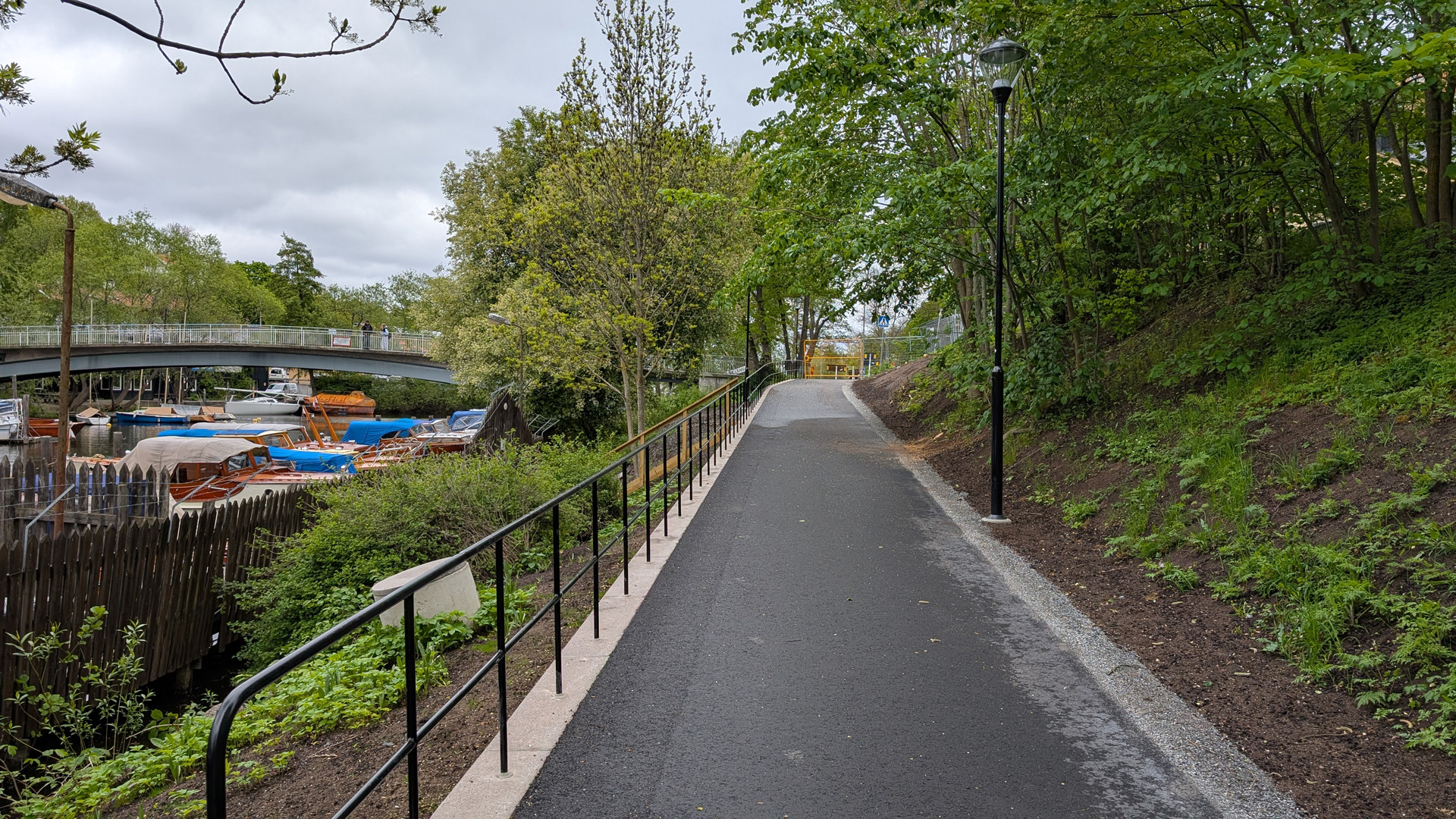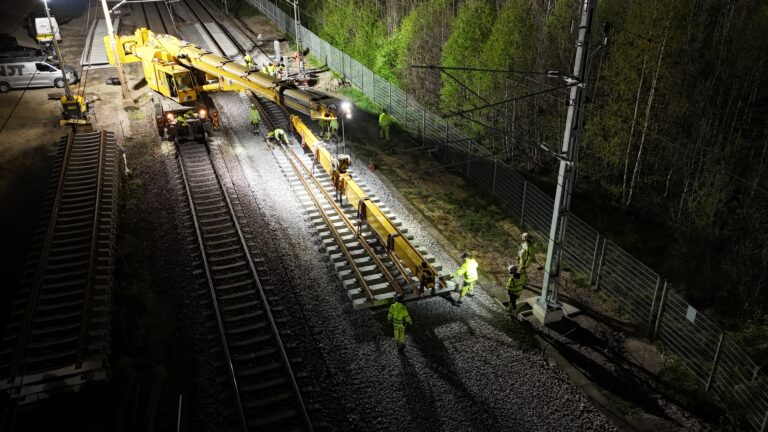NYAB reinforces the ground at Söder Mälarstrand
24.06.25At the northern shore of Södermalm in Stockholm lies the waterfront promenade Söder Mälarstrand. It stretches along Riddarfjärden from Pålsundet in the west to Centralbron in the east and is just over two kilometers long. The area has served as a quay for many hundreds of years, but as recently as the late 1800s, there was still no continuous shoreline street. The quay built in the 1930s deteriorated, as did several of the unseaworthy ships moored along the shoreline.
In the early 1990s, the city of Stockholm was forced to close the path at Pålsundet due to the risk of collapse. A new promenade was completed in 1997, and the area was renovated with a cycle and pedestrian path. Since then, the ground has settled again over several years, and the city decided it was time to find a long-term solution.
Complex and challenging circumstances
The proposal to build a cement quay was quickly rejected, and instead, it was decided to preserve the area’s natural environment, making a smaller impact on the site. This is where NYAB came into the picture, as we were entrusted to take care of this beautiful part of Stockholm. In August 2024, the project began to reinforce the ground along the shore to prevent it from collapsing into Riddarfjärden. The latest measurement showed that the ground had moved eight millimetres in three years and showed no signs of stopping.
One of the city’s requirements for the renovation was that the path should retain its charm and greenery. The procurement specified that as many as possible of the large old trees along the shore should be preserved, which NYAB has managed excellently. Piling with sparse sheet piles was chosen as the solution, as it allows the preservation of the trees’ roots.
“The work of placing the 900 piles is carried out very carefully and cautiously to avoid damaging the trees’ roots. Only a few trees have had to be felled, and most of them were diseased. We work closely with the city’s landscape architects and arborists on this important issue. Each tree that is removed will be replaced by two new ones,” says Olle Keijser, work manager at NYAB.

In the photo: work manager Olle Keijser and project engineer Emelie Zetterman.
Vacuum excavation saves the trees
First, a pre-excavation is vacuumed in the sheet pile line around the trees to see how the roots lie, then large stones and other debris in the ground are removed by hand. Vacuum excavation is gentle on the roots and requires no mechanical impact on them. The piles are then placed according to the construction documents but also based on the ground conditions. They should be spaced 50 centimeters apart, but sometimes they need to be adjusted by a few centimeters here and there, depending on how the roots grow. This way, the old, valuable trees are saved. The piles are drilled down to five meters where it is shallowest and 12 meters at the deepest points. When the work is finished, all the piles will be hidden in the ground.
Densely populated area
All projects have their challenges, and so does this one, which is ongoing in a central and densely built-up area. As in many places in Stockholm, there are many pipes and cables in the ground. This requires a lot, including many crossings and new connections. Some water and sewage parts are also quite old and fragile, some from the 1940s, which means that special solutions may be required to connect them with new parts while achieving good function and proper slope.
Another challenge is that the area is both densely populated and well-visited. Södermalm has 130,000 inhabitants, and the promenade is appreciated by both the local population and other Stockholmers. The path, with views of both Gamla Stan and the City Hall, is also popular with tourists. Cyclists, pedestrians, and joggers move along the promenade every day, and the stretch must always be kept passable.
“There is an enormous flow of people here. Both pedestrians, cyclists, and vehicle traffic must be redirected from time to time, and maintaining the necessary width requires a lot of work. But we solve it, says Olle Keijser.
Ground conditions require innovative thinking
Another challenge complicating the work on-site is the ground conditions. The settlements in the ground mean that it cannot be loaded to any great extent. Material must be transported back and forth with great caution, and the heavy steel pipes can only lie in certain places to avoid high ground pressure.
“No one had probably understood how much logistics it would involve carrying out this work, not least regarding the handling of the heavy steel pipes. We use our experience and solve the challenges together with creativity. The ground settlement also has a significant impact on how and where we can drive the machines. For the piling work, the smallest machine available is used. It also stands on a plate to distribute the pressure,” explains Olle Keijser, showing on a map where the ground can be loaded.

Extensive environmental requirements
An important factor for the city of Stockholm and which characterizes the work in the project is the extensive environmental sampling required. The project must stay ahead with sampling to avoid downtime, and excavation is not allowed in areas where environmental sampling has not been carried out. There are also many restrictions on where the masses can be transported and how they are handled. In total, several hundred samples must be coordinated and reported to be compiled.
Another challenge in the project is the proximity to the 90-year-old Västerbron, which is facing extensive renovation.
“The bridge is in great need of reinforcement, and we have strict directives that we must not touch it during our work. If that happens, the bridge must be closed and inspected, with significant consequences for traffic. Since the construction is so sensitive, we work very carefully when we are near the bridge,” says project engineer Emelie Zetterman.
Well-functioning cooperation and communication
Information to all concerned is an important factor for the project’s progress. Many people care about the place, and they naturally have questions about how the project is progressing, what work is coming next, and what the schedule looks like. NYAB’s employees always take the time to explain and engage in dialogue with them.
“We are keen to continuously communicate with everyone affected and involved. Therefore, we invest a lot in being inclusive and generous with information. It is about having an honest and transparent dialogue with the client, our partners, local residents, members of the boat clubs, and other stakeholders. We succeed very well with this.
Together and in consensus, the project solves problems, issues and challenges that arise. Unforeseen things happen, which is part of everyday life in the industry. For example, it may involve finding a pipe or cable in the ground even though it is not on the plans.
Solution oriented team
It is crucial that everyone is engaged and solution-oriented so that the work can continue without delay.
“I am glad that NYAB has been entrusted to preserve and improve this popular and central path. The new pedestrian and cycle path will be wider and have smoother slopes than the one we are replacing, while pedestrians and cyclists will be separated. This will contribute to better accessibility and traffic safety in the future,” says Olle Keijser.
A major phase of the project was completed in February 2025, and by spring 2026 the entire project will be finished. At that point, residents of Stockholm and tourists will be able to enjoy a revitalized, sustainable shoreline, a new park with a gym, seating by the water, and newly renovated paths for waterfront walks and cycling.


